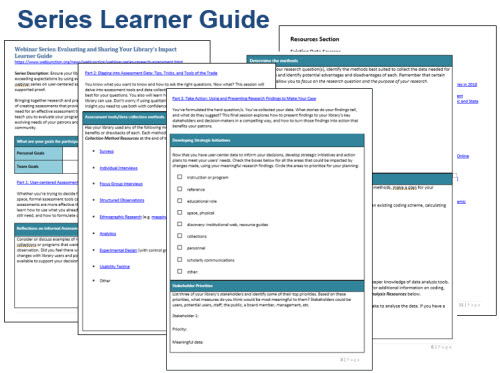Are You Ready to Dig into Assessment Data?
 Back in April, WebJunction and OCLC Research hosted the first webinar in a three-part series on assessing, evaluating and sharing your library’s impact. With nearly 300 attendees in the first session, we know that this topic is important to libraries of all types. More than half of the series registrants represent academic library communities, with mostly public libraries representing the rest, along with a few school, special and state library staff.
Back in April, WebJunction and OCLC Research hosted the first webinar in a three-part series on assessing, evaluating and sharing your library’s impact. With nearly 300 attendees in the first session, we know that this topic is important to libraries of all types. More than half of the series registrants represent academic library communities, with mostly public libraries representing the rest, along with a few school, special and state library staff.
These webinars bring together research and practice from across library sectors, covering the ins and outs of creating, and implementing assessments that provide insightful, actionable data. As a part of the series, we’re also providing a Learner Guide with activities to complete between sessions to help you and your colleagues get the most out of the experience.
In the first webinar of the series, User-centered Assessment: Leveraging What You Know and Filling in the Gaps, Lynn Silipigni Connaway and Kara Reuter, we explored the first three steps of the assessment process:
- Defining the problem
- Scanning the environment with existing data sources
- Preparing the planning
The learner guide is especially valuable for those working together as a team to explore your library’s assessment needs. We know of one cohort of learners working through the series and related exercises together. The cohort is comprised of members of the OCLC Research Library Partnership, and they have been gathering for virtual meetings as the newly-launched Library Assessment Interest Group. Senior Program Officer, Rebecca Bryant, shared an update in a Hanging Together blog post including recurring themes and high-level takeaways from their learning cohort.
With one month until the second webinar, Digging into Assessment Data: Tips, Tricks, and Tools of the Trade, we encourage you to explore pages 1-4 of the Learner Guide, so that you’re prepared to move on to the next steps in exploring data collection and analysis methods. The questions and activities in the first section of the guide can help lead your team through a user-centered approach in understanding your community and help you formulate the right research question to better meet user, potential users, and community needs/expectations. You’ll be able to articulate the primary problem or challenge you are seeking to understand and address and begin to frame your questions in order to investigate and support possible solutions.
In the August 14 webinar, we’ll dive into assessment tools and data collection and analysis methods and help you select the right method for your research question. And in the final October webinar, Take Action: Using and Presenting Research Findings to Make Your Case, we’ll look at the stories your research tells, and how to present findings to your library’s key stakeholders and decision-makers in a compelling way, and turn those findings into action that benefits your patrons.
We hope you’ll take advantage of the learning opportunities provided through these presentations and the learner guide. We look forward to hearing about your progress, either via the always active webinar chat or even through social media channels using the #libdata4impact hashtag.
